Tatsunori Hashimoto
Pre-training under infinite compute
Sep 18, 2025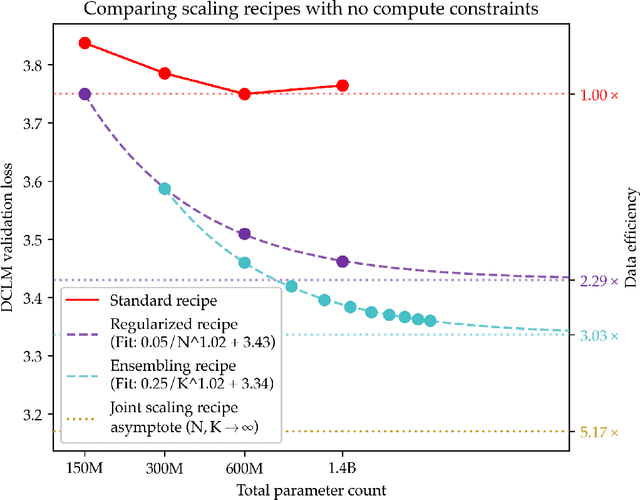

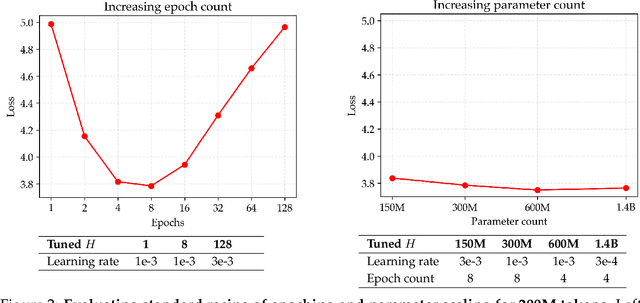
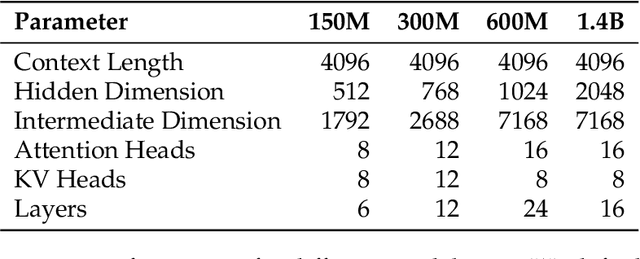
Abstract:Since compute grows much faster than web text available for language model pre-training, we ask how one should approach pre-training under fixed data and no compute constraints. We first show that existing data-constrained approaches of increasing epoch count and parameter count eventually overfit, and we significantly improve upon such recipes by properly tuning regularization, finding that the optimal weight decay is $30\times$ larger than standard practice. Since our regularized recipe monotonically decreases loss following a simple power law in parameter count, we estimate its best possible performance via the asymptote of its scaling law rather than the performance at a fixed compute budget. We then identify that ensembling independently trained models achieves a significantly lower loss asymptote than the regularized recipe. Our best intervention combining epoching, regularization, parameter scaling, and ensemble scaling achieves an asymptote at 200M tokens using $5.17\times$ less data than our baseline, and our data scaling laws predict that this improvement persists at higher token budgets. We find that our data efficiency gains can be realized at much smaller parameter counts as we can distill an ensemble into a student model that is 8$\times$ smaller and retains $83\%$ of the ensembling benefit. Finally, our interventions designed for validation loss generalize to downstream benchmarks, achieving a $9\%$ improvement for pre-training evals and a $17.5\times$ data efficiency improvement over continued pre-training on math mid-training data. Our results show that simple algorithmic improvements can enable significantly more data-efficient pre-training in a compute-rich future.
Synthetic bootstrapped pretraining
Sep 17, 2025Abstract:We introduce Synthetic Bootstrapped Pretraining (SBP), a language model (LM) pretraining procedure that first learns a model of relations between documents from the pretraining dataset and then leverages it to synthesize a vast new corpus for joint training. While the standard pretraining teaches LMs to learn causal correlations among tokens within a single document, it is not designed to efficiently model the rich, learnable inter-document correlations that can potentially lead to better performance. We validate SBP by designing a compute-matched pretraining setup and pretrain a 3B-parameter model on up to 1T tokens from scratch. We find SBP consistently improves upon a strong repetition baseline and delivers a significant fraction of performance improvement attainable by an oracle upper bound with access to 20x more unique data. Qualitative analysis reveals that the synthesized documents go beyond mere paraphrases -- SBP first abstracts a core concept from the seed material and then crafts a new narration on top of it. Besides strong empirical performance, SBP admits a natural Bayesian interpretation: the synthesizer implicitly learns to abstract the latent concepts shared between related documents.
The Ideation-Execution Gap: Execution Outcomes of LLM-Generated versus Human Research Ideas
Jun 25, 2025Abstract:Large Language Models (LLMs) have shown promise in accelerating the scientific research pipeline. A key capability for this process is the ability to generate novel research ideas, and prior studies have found settings in which LLM-generated research ideas were judged as more novel than human-expert ideas. However, a good idea should not simply appear to be novel, it should also result in better research after being executed. To test whether AI-generated ideas lead to better research outcomes, we conduct an execution study by recruiting 43 expert researchers to execute randomly-assigned ideas, either written by experts or generated by an LLM. Each expert spent over 100 hours implementing the idea and wrote a 4-page short paper to document the experiments. All the executed projects are then reviewed blindly by expert NLP researchers. Comparing the review scores of the same ideas before and after execution, the scores of the LLM-generated ideas decrease significantly more than expert-written ideas on all evaluation metrics (novelty, excitement, effectiveness, and overall; p < 0.05), closing the gap between LLM and human ideas observed at the ideation stage. When comparing the aggregated review scores from the execution study, we even observe that for many metrics there is a flip in rankings where human ideas score higher than LLM ideas. This ideation-execution gap highlights the limitations of current LLMs in generating truly effective research ideas and the challenge of evaluating research ideas in the absence of execution outcomes.
OpenThoughts: Data Recipes for Reasoning Models
Jun 05, 2025Abstract:Reasoning models have made rapid progress on many benchmarks involving math, code, and science. Yet, there are still many open questions about the best training recipes for reasoning since state-of-the-art models often rely on proprietary datasets with little to no public information available. To address this, the goal of the OpenThoughts project is to create open-source datasets for training reasoning models. After initial explorations, our OpenThoughts2-1M dataset led to OpenThinker2-32B, the first model trained on public reasoning data to match DeepSeek-R1-Distill-32B on standard reasoning benchmarks such as AIME and LiveCodeBench. We then improve our dataset further by systematically investigating each step of our data generation pipeline with 1,000+ controlled experiments, which led to OpenThoughts3. Scaling the pipeline to 1.2M examples and using QwQ-32B as teacher yields our OpenThoughts3-7B model, which achieves state-of-the-art results: 53% on AIME 2025, 51% on LiveCodeBench 06/24-01/25, and 54% on GPQA Diamond - improvements of 15.3, 17.2, and 20.5 percentage points compared to the DeepSeek-R1-Distill-Qwen-7B. All of our datasets and models are available on https://openthoughts.ai.
LongCodeBench: Evaluating Coding LLMs at 1M Context Windows
May 12, 2025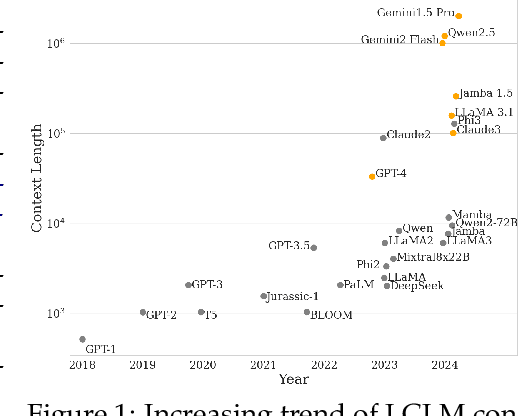

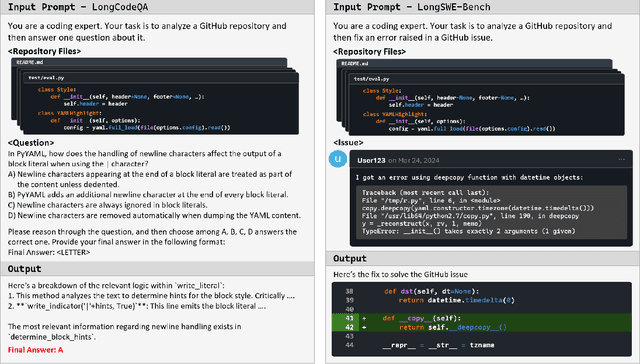

Abstract:Context lengths for models have grown rapidly, from thousands to millions of tokens in just a few years. The extreme context sizes of modern long-context models have made it difficult to construct realistic long-context benchmarks -- not only due to the cost of collecting million-context tasks but also in identifying realistic scenarios that require significant contexts. We identify code comprehension and repair as a natural testbed and challenge task for long-context models and introduce LongCodeBench (LCB), a benchmark to test LLM coding abilities in long-context scenarios. Our benchmark tests both the comprehension and repair capabilities of LCLMs in realistic and important settings by drawing from real-world GitHub issues and constructing QA (LongCodeQA) and bug fixing (LongSWE-Bench) tasks. We carefully stratify the complexity of our benchmark, enabling us to evaluate models across different scales -- ranging from Qwen2.5 14B Instruct to Google's flagship Gemini model. We find that long-context remains a weakness for all models, with performance drops such as from 29% to 3% for Claude 3.5 Sonnet, or from 70.2% to 40% for Qwen2.5.
Putting It All into Context: Simplifying Agents with LCLMs
May 12, 2025Abstract:Recent advances in language model (LM) agents have demonstrated significant potential for automating complex real-world tasks. To make progress on these difficult tasks, LM agent architectures have become increasingly complex, often incorporating multi-step retrieval tools, multiple agents, and scaffolding adapted to the underlying LM. In this work, we investigate whether all of this complexity is necessary, or if parts of these scaffolds can be removed on challenging tasks like SWE-bench. We show that in the case of SWE-bench, simply putting the entire environment into the context of a long context language model (LCLM) and properly prompting the model makes it competitive with carefully tuned, complex agent scaffolds. We show that a Gemini-1.5-Pro model without any scaffolding or tools achieves 38% on SWE-Bench-Verified, comparable with approaches using carefully tuned agent scaffolds (32%). While the unscaffolded approach with Gemini-1.5-Pro falls short of the strongest agentic architectures, we demonstrate that the more capable Gemini-2.5-Pro using the same unscaffolded approach directly attains a 50.8% solve rate. Additionally, a two-stage approach combining Gemini-1.5-Pro with Claude-3.7 achieves a competitive 48.6% solve rate.
One-Minute Video Generation with Test-Time Training
Apr 07, 2025Abstract:Transformers today still struggle to generate one-minute videos because self-attention layers are inefficient for long context. Alternatives such as Mamba layers struggle with complex multi-scene stories because their hidden states are less expressive. We experiment with Test-Time Training (TTT) layers, whose hidden states themselves can be neural networks, therefore more expressive. Adding TTT layers into a pre-trained Transformer enables it to generate one-minute videos from text storyboards. For proof of concept, we curate a dataset based on Tom and Jerry cartoons. Compared to baselines such as Mamba~2, Gated DeltaNet, and sliding-window attention layers, TTT layers generate much more coherent videos that tell complex stories, leading by 34 Elo points in a human evaluation of 100 videos per method. Although promising, results still contain artifacts, likely due to the limited capability of the pre-trained 5B model. The efficiency of our implementation can also be improved. We have only experimented with one-minute videos due to resource constraints, but the approach can be extended to longer videos and more complex stories. Sample videos, code and annotations are available at: https://test-time-training.github.io/video-dit
Reasoning to Learn from Latent Thoughts
Mar 24, 2025Abstract:Compute scaling for language model (LM) pretraining has outpaced the growth of human-written texts, leading to concerns that data will become the bottleneck to LM scaling. To continue scaling pretraining in this data-constrained regime, we propose that explicitly modeling and inferring the latent thoughts that underlie the text generation process can significantly improve pretraining data efficiency. Intuitively, our approach views web text as the compressed final outcome of a verbose human thought process and that the latent thoughts contain important contextual knowledge and reasoning steps that are critical to data-efficient learning. We empirically demonstrate the effectiveness of our approach through data-constrained continued pretraining for math. We first show that synthetic data approaches to inferring latent thoughts significantly improve data efficiency, outperforming training on the same amount of raw data (5.7\% $\rightarrow$ 25.4\% on MATH). Furthermore, we demonstrate latent thought inference without a strong teacher, where an LM bootstraps its own performance by using an EM algorithm to iteratively improve the capability of the trained LM and the quality of thought-augmented pretraining data. We show that a 1B LM can bootstrap its performance across at least three iterations and significantly outperform baselines trained on raw data, with increasing gains from additional inference compute when performing the E-step. The gains from inference scaling and EM iterations suggest new opportunities for scaling data-constrained pretraining.
FSPO: Few-Shot Preference Optimization of Synthetic Preference Data in LLMs Elicits Effective Personalization to Real Users
Feb 26, 2025Abstract:Effective personalization of LLMs is critical for a broad range of user-interfacing applications such as virtual assistants and content curation. Inspired by the strong in-context learning capabilities of LLMs, we propose Few-Shot Preference Optimization (FSPO), which reframes reward modeling as a meta-learning problem. Under this framework, an LLM learns to quickly adapt to a user via a few labeled preferences from that user, constructing a personalized reward function for them. Additionally, since real-world preference data is scarce and challenging to collect at scale, we propose careful design choices to construct synthetic preference datasets for personalization, generating over 1M synthetic personalized preferences using publicly available LLMs. In particular, to successfully transfer from synthetic data to real users, we find it crucial for the data to exhibit both high diversity and coherent, self-consistent structure. We evaluate FSPO on personalized open-ended generation for up to 1,500 synthetic users across across three domains: movie reviews, pedagogical adaptation based on educational background, and general question answering, along with a controlled human study. Overall, FSPO achieves an 87% Alpaca Eval winrate on average in generating responses that are personalized to synthetic users and a 72% winrate with real human users in open-ended question answering.
Auditing Prompt Caching in Language Model APIs
Feb 11, 2025



Abstract:Prompt caching in large language models (LLMs) results in data-dependent timing variations: cached prompts are processed faster than non-cached prompts. These timing differences introduce the risk of side-channel timing attacks. For example, if the cache is shared across users, an attacker could identify cached prompts from fast API response times to learn information about other users' prompts. Because prompt caching may cause privacy leakage, transparency around the caching policies of API providers is important. To this end, we develop and conduct statistical audits to detect prompt caching in real-world LLM API providers. We detect global cache sharing across users in seven API providers, including OpenAI, resulting in potential privacy leakage about users' prompts. Timing variations due to prompt caching can also result in leakage of information about model architecture. Namely, we find evidence that OpenAI's embedding model is a decoder-only Transformer, which was previously not publicly known.
 Add to Chrome
Add to Chrome Add to Firefox
Add to Firefox Add to Edge
Add to Edge